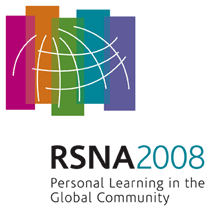
Abstract Archives of the RSNA, 2008
SSE08-04
Acute Obscure Intestinal Bleeding: Detection and Localization with Angiographic-assisted 64-row MDCT Angiography
Scientific Papers
Presented on December 1, 2008
Presented as part of SSE08: Gastrointestinal (Acute Abdomen)
Yun Chiao Chen, Presenter: Nothing to Disclose
Gin-Chung Liu MD, Abstract Co-Author: Nothing to Disclose
Ding-Kwo Wu MD, Abstract Co-Author: Nothing to Disclose
Yu-Ting Kuo MD, Abstract Co-Author: Nothing to Disclose
Paul Ming-Chen Shih MD, Abstract Co-Author: Nothing to Disclose
Twei-Shiun Jaw MD, Abstract Co-Author: Nothing to Disclose
To evaluate diagnostic performance of angiographic-assisted CT angiography (CTA) for acute intestinal bleeding of obscure origin with a 64-row MDCT scanner
Twenty-one consecutive patients with melena and clinically suspected acute intestinal bleeding were included. The patients underwent catheterization of the superior mesenteric artery followed by a CTA with a 64-row MDCT scanner before and after intra-arterial injections of a non-ionic contrast [Ultravist and saline, ratio: 1:1, 60ml]. The contrast injection rate was 5ml/s. The scan delay was 5s and 35s. We reconstructed raw datasets for 3D CTA and MIP reformatted images. We evaluated the delay–scan images (35s) first to identify if presence of extravasation of contrast medium into bowel lumen. We then investigated the early-scan images (5s) to determine the bleeding source. All patients then underwent conventional angiography (CA). The results of CTA and CA were compared with surgical findings and clinical follow up as standards.
Angiographic-assisted CTA revealed active bleeding in 18 (86%) of 21 patients. Ten of 18 patients were also demonstrated on standard CA and confirmed by operation. Four of 18 patients were revealed only by the selective CA under CTA guiding. Among them, three patients were confirmed by operation (underwent surgery, and one jejunal angiodysplasia which was treated by transcatheter embolization. One of 18 patients with jenunal angiodysplasia showed no bleeding on selective CA even under the CTA guiding. The patient was confirmed by surgery with intra-arterial catheter localization under the CTA guiding. Three of 18 patients showed multiple areas of contrast extravasations on CTA, but negative on CA. They received medical treatment. Three (14%) of 21 patients were negative on CTA and CA. Bleeding ceased in two patients during 3- to 5–month follow-up. One patient in this group failed to be followed by us.
Angiographic-assisted CTA with a 64 row MDCT scanner outperformed CA in detection and localization of acute intestinal bleeding of obscure origin. It also serves as a guide for subsequent selective CA, which provides useful information for the following surgery and transcatheter embolization.
Angiographic-assisted CTA with MDCT not only outperforms CA in diagnosing acute obscure intestinal bleeding, but also serves as an imaging guide for the following therapies.
Chen, Y,
Liu, G,
Wu, D,
Kuo, Y,
Shih, P,
Jaw, T,
Acute Obscure Intestinal Bleeding: Detection and Localization with Angiographic-assisted 64-row MDCT Angiography. Radiological Society of North America 2008 Scientific Assembly and Annual Meeting, February 18 - February 20, 2008 ,Chicago IL.
http://archive.rsna.org/2008/6010652.html

